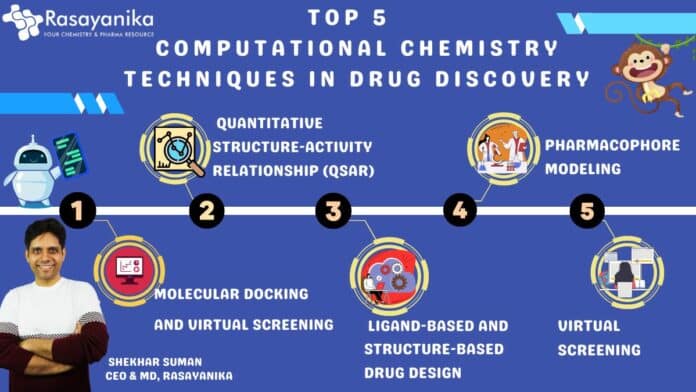In the realm of modern drug discovery, computational chemistry has emerged as a powerful tool that accelerates the identification and development of new therapeutic compounds. Leveraging the computational power of computers, these techniques enable scientists to simulate and predict the behavior of molecules, saving time and resources in the drug development process. In this article, we will explore the top five computational chemistry techniques that are transforming the landscape of drug discovery.
Molecular Docking:
Molecular docking is a technique used to predict the binding affinity and orientation of a small molecule, known as a ligand, to its target protein. By simulating the interactions between the ligand and the target, researchers can identify potential drug candidates and optimize their binding properties. Molecular docking plays a crucial role in rational drug design, helping scientists to predict the efficacy and specificity of a drug before it is synthesized and tested in the laboratory.
Virtual Screening:
Virtual screening involves the computational screening of large databases of compounds to identify molecules with the potential to bind to a specific target of interest. By employing various algorithms and scoring functions, virtual screening helps prioritize the selection of lead compounds for further experimental evaluation. This technique greatly
expedites the initial stages of drug discovery by reducing the number of compounds that need to be synthesized and tested, saving both time and resources.Quantitative Structure-Activity Relationship (QSAR):
QSAR is a computational modeling technique that correlates the chemical structure of a compound with its biological activity. By analyzing the structure-activity relationship of a set of known compounds, QSAR models can predict the activity of new compounds against a particular target. This allows researchers to prioritize and design compounds with optimized biological properties. QSAR models have become invaluable tools in lead optimization and predicting the pharmacokinetic properties of potential drug candidates.
Molecular Dynamics Simulation:
Molecular dynamics simulation involves the simulation of the movements and interactions of atoms and molecules over time. By applying classical physics laws, molecular dynamics simulations provide insights into the behavior of biomolecules and their interactions with drug molecules. This technique helps researchers understand the dynamic behavior of drug-target complexes, explore binding mechanisms, and assess the stability of protein-ligand interactions. Molecular dynamics simulations provide valuable information for drug design and optimization.
Pharmacophore Modeling:
Pharmacophore modeling is a technique used to identify the essential features and spatial arrangement required for a molecule to interact with a target protein. By creating a three-dimensional model of the pharmacophore, researchers can predict and design new compounds that possess similar structural features and binding capabilities. Pharmacophore modeling aids in the identification of novel lead compounds and the optimization of their biological activity and selectivity.
Ligand-Based Drug Design: A Tailor-Made Approach 🧵✂️
Ligand-based drug design revolves around the properties of the target’s binding site and the ligand (molecule) itself. By studying the interactions between ligands and target proteins, scientists can develop new compounds that mimic the desired interactions, leading to enhanced therapeutic effects. It’s like tailoring a perfect fit! 🔍✨
Structure-Based Drug Design: Unveiling the Blueprint 🏗️📐
Structure-based drug design delves into the three-dimensional structure of target proteins. Using techniques like X-ray crystallography and computational modeling, researchers identify key binding sites and design compounds that precisely fit into these sites, modulating protein activity. It’s like unraveling the blueprint for success! 📊🔬
Both approaches offer unique advantages and complement each other in the quest for effective drugs. 💪🌍
Ligand-based and structure-based drug design pave the way for numerous benefits:
✅ Accelerated Drug Discovery: By focusing on specific interactions and structures, these approaches streamline the drug discovery process, reducing time and resources required.
✅ Target-Specific Design: Tailoring compounds based on ligand-protein interactions or protein structure enables the development of drugs with enhanced efficacy and specificity.
✅ Optimization and Lead Identification: These techniques aid in lead optimization, improving the properties and characteristics of potential drug candidates.
✅ Overcoming Challenges: Ligand and structure-based approaches provide solutions to challenging targets, including protein-protein interactions and allosteric sites.
Conclusion:
Computational chemistry techniques have revolutionized the field of drug discovery, offering powerful tools to accelerate the identification and optimization of potential therapeutic compounds. From molecular docking and virtual screening to QSAR, molecular dynamics simulations, and pharmacophore modeling, these techniques provide valuable insights into the behavior of molecules and their interactions with target proteins. As computational power continues to advance, these techniques will play an increasingly vital role in the development of new drugs, ultimately benefiting patients worldwide.
Remember, computational chemistry is a rapidly evolving field, and staying updated with the latest techniques and advancements is crucial for aspiring chemists. Embracing computational tools alongside experimental methods opens up exciting possibilities for innovation and breakthroughs in the quest for new and improved treatments.
Subscribe to Rasayanika for the latest chemistry and Pharma job openings, follow us on Facebook and Telegram and subscribe to our youtube channel for the latest updates on chemistry and Pharma jobs and much more.

















































